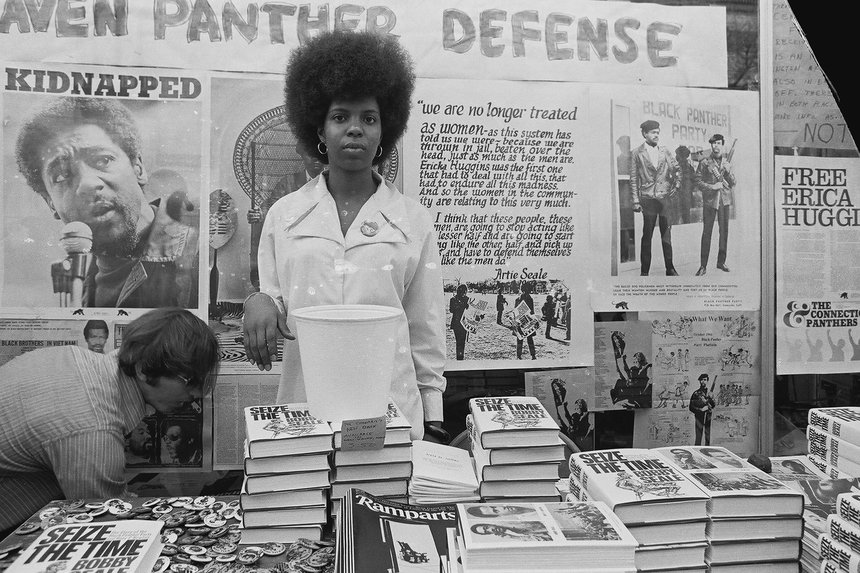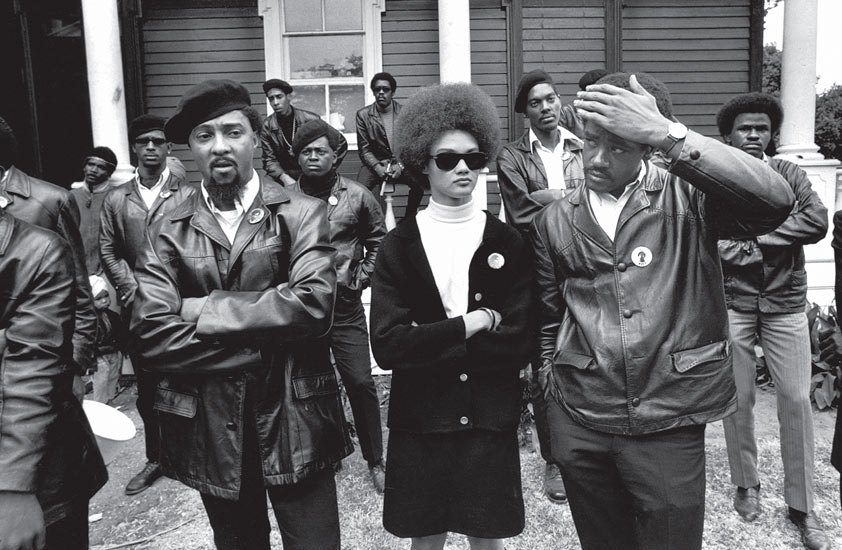Writing an Organizational History of the Black Panthers: An Author’s Response
This post is part of our online roundtable on Robyn Spencer’s The Revolution Has Come

Although I received my formal training as a historian from Columbia University’s History Department, I credit Brooklyn’s Medgar Evers College for schooling me on Black grassroots organizations. In the 1990s, Medgar boasted a predominantly working-class student body and was as much an educational institution as a Black political hub. Located across the street from Ebbets Field, a towering affordable housing complex, and just minutes from where I grew up in East Flatbush, Medgar stood a world away from what Columbia represented—Manhattan’s largest landowner with homelessness, literally and figuratively, at its gates. In 1995, I started volunteering at the Center for Women’s Development while I began the dissertation research that anchored The Revolution Has Come: Black Power, Gender, and the Black Panther Party in Oakland.
At Medgar, I gravitated towards the many community-based Black Nationalist, Marxist, feminist, and Pan Africanist organizations thriving in the porous borders between campus and community. Groups like the Black Panther Party Collective, the Free Mumia Coalition, the Patrice Lumumba Coalition, and others moved me from individual outrage to collective action in the face of poverty and police violence at home, apartheid and colonialism abroad, and omnipresent sexism. In these organizations, I honed pragmatic political skills, experienced comradeship, wrangled with political repression, and felt the euphoria of hope. As a budding movement scholar, these experiences reinforced the importance of political organizations.
Because of my experiences at Medgar, The Revolution Has Come is, first and foremost, an organizational history. I trace the Black Panther Party’s transformation from a group of six friends from a shared neighborhood to a nationwide and international network, and finally, an assemblage of regional offices. Readers learn about how the BPP financed itself, how leaders interacted with rank-and-file members, how inter-organizational communications worked, how repression was experienced, and what it meant to wake up every day as an Oakland Panther. I pay particular attention to the role of women. Their presence and impact on the Panthers’ organizational evolution is undeniable. Readers will encounter women’s hands doing the clerical work, creating art, authoring speeches, shackled in handcuffs, tending to children, trapped in the crosshairs of repression, and, yes, holding the guns. (This too is a legacy of Medgar. Women constituted seventy percent of the students and experiences on and off campus provided abundant examples of both grassroots Black feminism and a deep resistance to women’s leadership.)
I’m grateful to Black Perspectives for the opportunity to respond to the comments on The Revolution Has Come so generously provided by six leading scholars: Michael Ezra, Ashley D. Farmer, Garrett Felber, Ibram Kendi, Tracy E. K’Meyer, and Quito Swan. My extended remarks are forthcoming in the Journal of Civil and Human Rights. Here, I will engage their feedback through the lens of organizational history, framed by entries from the journal I kept during my first Bay Area research trip in 1996.
***
July 11, 1996: No one ever talks about the Panthers as an organization, as a place where people were kind of “growing up” or developing, falling in love, out of love, discovering political ideologies, experiencing brotherhood/sisterhood/comradeship.
Michael Ezra’s review identified the ability of The Revolution Has Come to illuminate and demystify daily life within the Oakland Panthers as one of its greatest contributions to the burgeoning literature on the Black Panther Party. Every good organizational history needs a source base capable of revealing the bones of the organization. Although I would visit other repositories around the Bay Area and the country by the end of my research journey, The Revolution Has Come rests on the over ninety boxes of organizational records sold to Stanford University by the Dr. Huey P. Newton Foundation Inc. in 1996. Thanks to Clayborne Carson and the Black Panther Party Research Project, I was one of the first researchers to view the Newton Foundation Collection. I saw the deposited materials in a semi-unprocessed state. Despite the haphazard nature of storage and the passage of time, the logic of the Panthers’ organizational scheme was still discernable. My methodology was simple (and unwise): read everything. I spent four months in Palo Alto—a context I found alienating—doing work in the archives that I found, in turn, both tedious and transformative.
July 1, 1996: “Today was my first day in the Newton archives. The time flew by.”
July 10, 1996: “I am exhausted already and it’s only 9:20. [Start time: 9 a.m.] This is exhausting. Here am I, in this context of unmitigated wealthy whiteness, seeking the soul of the Panthers. Am I up to this task?”
August 5, 1996: “I am very touched by all this material. Sometimes when I look up from my folder and look around and realize where I am, I feel like I have traveled on a long journey. I feel like the material has transported me somewhere else.”
Adopting an organizational lens raised questions I hadn’t considered. BPP organizational records revealed the dailyness of struggle. The memos, minutes from meetings, letters, artwork, pictures, wiretap transcripts, poems, trial documents, FBI records, speeches, flyers, news clippings, directives, press releases, daily work reports, manuscripts, audiotapes, videotapes, and photographs unveiled an inner life that was vibrant and visionary, authoritarian and democratic, and besieged by political repression.
Tracy E. K’Meyer notes that The Revolution Has Come demonstrates how “living in a revolutionary organization meant living under persistent attack, and the toll that could take on the day-to-day experience of, and relationships between, the members.” Her review captures one of those tolls: emotions like fulfillment and hope can remain implied rather than expressed.
The archives provided ample evidence of how women’s experiences were shaped by political repression. Gender and repression were so prevalent and inextricably linked that I could neither disentangle one from the other nor corral them into any singular locale in the book.
July 1, 1996: “The level of FBI machinations revealed in the FOIA documents astound me. Even me. I have decided that rather than a separate chapter on COINTELPRO that I am going to make it a constant theme that runs throughout, not something that you can separate out.”
September 4, 1996: “What became clear as I started reading through the material is that there was no way to “separate out” women. Women were everywhere, participating on all levels, at all times. The level of introspection and internal debate on various gender issues by both men and women was intense.”

Garrett Felber’s and Ashley Farmer’s reviews emphasize how retelling the familiar story of repression through Panther women’s lives opens new conceptual grounds. Farmer notes that “studies that do not account for the intersections of women, gender, and surveillance underestimate the extent and effects of Black Power-era political repression.” Felber points out that “state repression also opened avenues for the expansion of women’s roles within the organization.” In the interviews, Brenda Pressley described the impact of the FBI visiting her parents threateningly and Kathleen Cleaver revealed how the FBI fueled marital discord. Their testimony helped me understand how multifaceted and insidious this repression really was.
July 31, 1996: “I am getting to know people thru these records.”
Oral histories were central to my methodology, and I conducted over forty interviews with Panthers around the country. Ibram Kendi’s review focuses on the organizational insights gleaned from my interviews with Amar Casey. Casey joined the wave of people relocating to Oakland to participate in the Panthers’ election campaigns in the 1970s. His work in election campaigns and community programs demonstrates the realities of being a full-time organizer. His “personal” life was not private or apolitical. Casey’s story provides glimpses into the collective lifestyle that Party rank-and-file adopted in the 1970s and the conflicts and cooperation it engendered.
Quito Swan concludes that The Revolution Has Come “links the Black Power Movement to the Black Lives Matter Movement and contemporary Black activism” with a decidedly activist orientation. Felber notes that it should prompt readers to ask “How do histories of organizations, rather than leaders, enable us to envision new forms of freedom struggle?”
July 11, 1996: “I want to figure out the legacy of the Black Panther Party to the Black Liberation movement. You can’t read and learn about the Black Panther Party and do nothing. I couldn’t.”
In 2017, as organizations like Black Lives Matter, Cooperation Jackson, Black Women’s Blueprint, Black for Palestine, Southerners on New Ground, and the Dream Defenders struggle for a better future, it is clear that they urgently need a past—a scholarly rendering of their political genealogy in the Black freedom movement then and now.
The revolution has come, and it demands the organizational history of the Student Nonviolent Coordinating Committee (after 1966), the Revolutionary Action Movement, the Republic of New Afrika, the League of Revolutionary Black Workers, the Third World Women’s Alliance, the National Black Antiwar Antidraft Union, and others. Who will seize the time?
Copyright © AAIHS. May not be reprinted without permission.

Extraordinary and powerful, Robyn. Thank you for this reminder of why we do the work…and the work that remains to be done. Seize the time, indeed.
Thanks for this comment, Russell. History matters in so many fundamental ways.
Thanks Robyn, looking forward to reading this.
Hey, Ms. Spencer! I’ve happily kept track of your work since meeting you in the 00’s @ Geneseo conference and am so gratified to be reading your book. Kudos to you for bringing it to fruition in the principled way you have while attending to family and other urgent matters. You and others of your generation are doing such inspirational work. Thank you!
Prof. Brooks!! Thanks for this encouragement and support. That conference organized by Prof. Emilye Crosby was phenomenal. I’ll never forget the lessons learned, the conversations and the people. Take care.